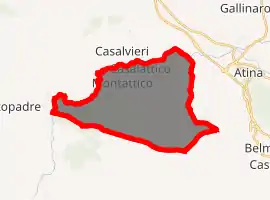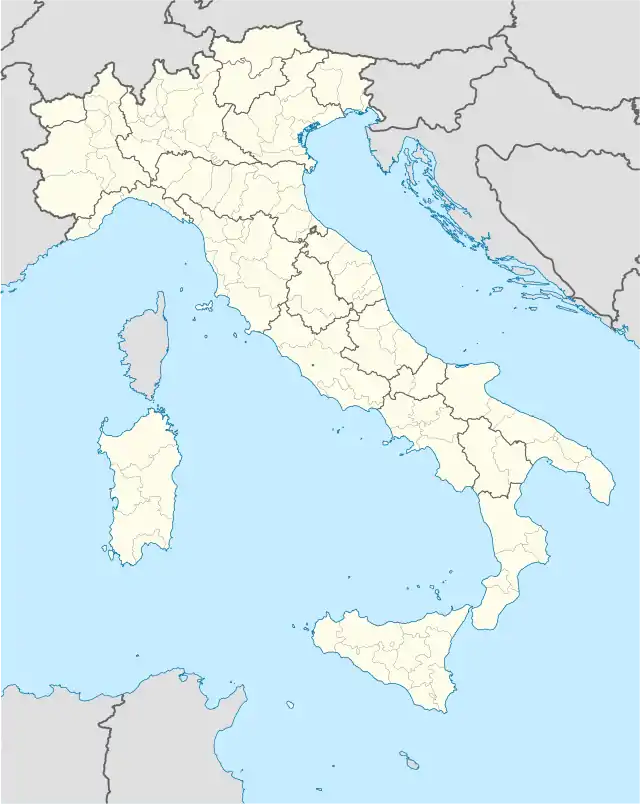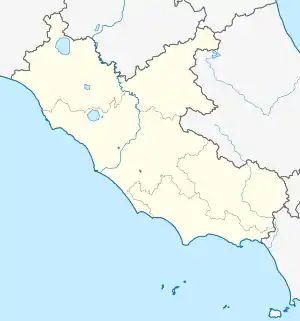Casalattico
Casalattico (Campanian: Casale) is a comune (municipality) in the Province of Frosinone in the Italian region of Lazio. The village is located about 110 kilometres (68 mi) southeast of Rome and about 30 kilometres (19 mi) east of Frosinone.
Casalattico | |
|---|---|
| Comune di Casalattico | |
 | |
Location of Casalattico 
| |
 Casalattico Location of Casalattico in Italy  Casalattico Casalattico (Lazio) | |
| Coordinates: 41°37′N 13°44′E | |
| Country | Italy |
| Region | Lazio |
| Province | Province of Frosinone (FR) |
| Frazioni | Montattico, Monforte, Sant'Andrea, Macchia, Verticchio, San Nazario |
| Government | |
| • Mayor | Giuseppe Benedetti |
| Area | |
| • Total | 28 km2 (11 sq mi) |
| Elevation | 420 m (1,380 ft) |
| Population (28 February 2017)[2] | |
| • Total | 556 |
| • Density | 20/km2 (51/sq mi) |
| Demonym(s) | Casalatticesi |
| Time zone | UTC+1 (CET) |
| • Summer (DST) | UTC+2 (CEST) |
| Postal code | 03030 |
| Dialing code | 0776 |
| Patron saint | Barbatus of Benevento |
| Saint day | 19 February |
| Website | Official website |
It is home to a summer Irish festival celebrating the local families that moved to Ireland with the twinning of the town with Naas in Co kildare Ireland. The festival hosts Irish folk music and local artists. The nearby Melfa river, an tributary of the Liri river, flows in the commune. The town houses the local commune offices and postal services. The commune boundary is bounded by the communes of Atina and Casalvieri on one side and Colle San Magno and Terelle, Arpino, and Santopadre on the other. Casalattico is surrounded by mountains reaching up to 1700 meters. The Casalattico town irrigation denomination is Apenninica Monte Cairo including Atina, and Villa Latina. The average size of a land parcel held privately in Casalattico is approximately 7 acres.
.svg.png.webp)
History
Casalattico has been a small but pivotal player in the area's history and economy. The small, sleepy hilltop town maintains a reduced population during the winter months and an explosion of numbers during the summer festive months of August. Great family global ties are still very strong in the town belie its small size. The church of San Barbato with its Norman style belfry and bell dominate the central piazza.
The Roman entrepreneur and banker Titus Pomponius Atticus 110-32 BC is believed to have had a villa in what is now the frazione of Montattico. There are some carvings referencing the name Pomponius and some of the constructions attributed to him. In his later years, he married a relative, Caecilia Pilea/Pilia (c. 75 – 46 BC), daughter of Pileus/Pilius and a maternal granddaughter of the Triumvir, Crassus. Atticus and Pilea/Pilia were married in 58/56 BC, when Atticus was already 53/54 years old, and she died after 12 years of happy marriage. She bore him a son of the same name, Titus Pomponius Atticus (of whom little is known), as well as a daughter, Caecilia Pomponia Attica, who became the first wife of Marcus Vipsanius Agrippa. Agrippa was from Arpino, then called Arpinum. The Casalattico area includes the medieval ruins of the ancient Benedictine monastery of Sant'Angelo in Pesco Mascolino 780 AD, and an earlier wonderful example of a Roman bridge at the Melfa river. Other Roman remains are found in the archaeological site of San Nazario. The previous tithes of the church of San Nazario were paid to the Abbey of Montecassino until the 1600s AD. There are examples of church art dating from 1855 and a bell with the name don Gabriele.
Immigration to America
Maria Taddei of the Taddei family emigrated to New York in 1939. On the liner REX from Genoa.SS Rex was an Italian ocean liner launched in 1931. The popular Liner held the westbound Blue Riband between 1933 and 1935. Originally built for the Navigazione Generale Italiana (NGI) as SS Guglielmo Marconi, its state-ordered merger with the Lloyd Sabaudo line meant that the ship sailed for the newly created Italia Flotta Riunite (Italian Line).Rex operated transatlantic crossings to America from Italy with its running mate, Conte di Savoia prior to the outbreak of the Second World War. Rex maintained a commercial service in the Mediterranean Sea for a short period, but when Italy entered the war in June 1940 Rex was laid up for safe-keeping. On 8 September 1944, off Koper, Rex was hit by 123 rockets launched by Royal Air Force aircraft, caught fire from stem to stern. She burned for four days, then rolled onto the port side, and sank in shallow water. The ship was broken up at the site beginning in 1950. Many other families associated with American immigration would have used the Rex, Fusco, Cafolla, Cervi, Uzzolino to mention a few from the Casalattico area.
Immigration to England
Charles Forte, Scottish caterer and hotelier, was born in the frazione of Mortale, now called Monforte, in 1908.Charles Forte was born as Carmine Forte in Mortale, now Monforte, Casalattico, in the province of Frosinone, Italy on 26 November 1908. He emigrated from Italy to Scotland at the age of four with his family. He attended Alloa Academy and then St. Joseph's College, Dumfries as a boarder, followed by two years of studies in Rome. After Rome, Forte rejoined his family, who had moved to Weston-super-Mare, where his father ran a cafe with two cousins. Charles's main training at the age of 21 came in Brighton, where he managed the Venetian. At 26, he set up his first "milk bar" in 1935, the Strand Milk Bar Ltd, in [ the location. Soon he began expanding into catering and hotel businesses. At the outbreak of World War II, Forte was interned in the Isle of Man due to his Italian nationality, but he was released after only three months. After the war, his company became Forte Holdings Ltd and bought the Cafe Royal in 1954. In the 1950s, he also opened the first catering facility at Heathrow Airport and the first full British motorway service station for cars at Newport Pagnell, Buckinghamshire, on the M1 motorway in 1959. He purchased the Hungarian Restaurant in Lower Regent St. in 1955.[citation needed]' England a great host to many family names including Taddei, Fusco, Tullio, and others.
Immigration to Ireland
In the late 19th and early 20th century a significant number of young people left Casalattico to work in Ireland, with many founding chip shops there. Up to 8,000 Irish-Italians have ancestors from Casalattico and nearby Picinisco and other local towns like Casalvieri and Atina, La Macchia, San Donato, Settefrati and a collection of smaller towns and commune. Immigration to France and England along with America and Canada also popular destinations for the immigrants. Cav. Ufficiale C.B. Fusco born in San Nazario in the valley emigrated to Ireland in 1952 a most common occurrence during this period of post war shortages. The Italian population has been represented in Ireland since the early 1900s. Other popular names associated with the Casalattico and the Comino valley generally others are; Forte, Macari, Morelli, Borza, Cafolla, Taddei, Nardone, Vella, Fusco, Magliocco and others. Four or five generations later in Ireland and the families have diversified greatly the heritage food business is generally in decline and new opportunities are taken up by the young in technology.
Middle Ages
The centre Piazza vista is to the west predominately and has an example of a Norman fortification style tower 1200 AD. The hilltop town has no moat and is accessible by one winding access road passing the graveyard to the left on approach. The town to day has still maintained its medieval aspect and the small winding pedestrian little streets are a testament to its history. There are some names associated with the area of note from the medieval period in the form of Condottiere or knights, A references to Ettore di Atina having owned land at San Nazario and a Pietro di San Germano being involved with the little church at San Nazario. The centre piazza of Casalattico suffered some earthquake damage and tremors to the central church tower of San Barbato during the 1990s but now all repaired. The town now contains a restaurant 'La Piazza' owned and operated by Carmine Cerifice born in Birr, County Offaly, Ireland.
.svg.png.webp)
History
The Valcomino valley derives its name from the Samnite peoples and Sabellic tribes that inhabited the area generally in 400 BC. Cominum was the stronghold of the Samnites until the end of the third Samnite war with Rome and their final assimilation into the Western Empire of Rome. The name is preserved in the Valcomino title of today. Historical references by Cicero and Plutarch refer to a residence of one Caius Pomponius Atticus a noble family descendant of Rome and personal friend of Cicero. Cicero and his brother Quintus were from Arpino a nearby town. Some constructions have been attributed to Atticus namely a Roman six-arch bridge crossing the Melfa river below Casalattico, of which one complete arch remains and a written stone in MontAttico town.
Several examples of the historically famous Polygonal Walls style exist in the Casalattico area, This wall building style large attributed to the Samnite and sabellic tribes. Examples exist on the valley floor near Alvito, and in Atina, Arpino and as far away as the foundations of sections of the Montecassino Abbey including Settefrati, Arpino. According to Livy the historian, the two Roman consuls for 343 AD, Marcus Valerius Corvus and Aulus Cornelius Cossus, both marched with armies against the Samnites. Valerius led his army into Campania and Cornelius his into Samnium where he camped at Saticula. Livy then goes on to narrate how Rome won three different battles against the Samnites. Valerius won the first battle, fought at Mount Gaurus near Cumae, only after a last desperate charge in fading daylight finally routed the Samnites after a day of hard fighting. The second battle almost ended in disaster for the Romans when the Samnites attempted to trap the other consul, Cornelius Cossus, and his army in a mountain pass. Fortunately for them, one of Cornelius' military tribunes, Publius Decius Mus was able to lead a small detachment to seize a hilltop, distracting the Samnites and allowing the Roman army to escape the trap. Decius and his men slipped away to safety during the night, the morning after the unprepared Samnites were attacked and defeated by the Romans. Still determined to seize victory, the Samnites collected their forces and laid siege to Suessula at the eastern edge of Campania. Leaving his baggage behind, Marcus Valerius took his army by forced marches to Suessola. Low on supplies, and underestimating the size of the Roman army, the Samnites scattered their army to forage for food. This gave Valerius the opportunity to win a third Roman victory when he first captured the Samnites' lightly defended camp and then scattered their foragers. These Roman successes against the Samnites convinced Falerii to convert her forty years truce with Rome into a permanent peace treaty, and the Latins to abandon their planned war against Rome and instead campaign against the Paeligni. The friendly city-state of Carthage sent a congratulatory embassy to Rome with a twenty-five pound crown for the Temple of Jupiter Optimus Maximus. Both consuls then celebrated triumphs over the Samnites. The Fasti Triumphales records that Valerius and Cornelius celebrated their triumphs over the Samnites on 21 September and 22 September respectively.Close by on the main road accessing Casalattico is a collection of Roman and Samnite stones of the pre-Roman Samnite period and later Roman Period, authenticated by Sora Natural History Museum. There is also on the same road the Municipal Graveyard, and tombs 1750 AD approx. On the same approach road of Via Provinciale is the small hamlets of Lo Schito and Localita Vertichio, San Andrea, San Nazario. San Nazario notable for the existence of one of the oldest churches in Italy. Originally a Benedictine Monastery of some note in 1030 AD. The documented dates supported by the Montecassino scriptorium give clear dates of 1030 AD. This church of San Nazario Vescovo as it was called of old is in Private ownership today. These various hamlets come under the control of Casalattico county Comune.
Just off the main approach road there still exists a Mill also dating from 1030 AD also and is now a small Museum of Local farming Culture and Artifacts by Casal Attici a caretaker group in the area. The fundamental changes made to the River Melfas meandering stage by the Hydroelectric Dam upstream has left the Mill in land and Dry. The Source of the Melfa river is in Canneto in the Abruzzi mountains at the Site of the original Temple of the Goddess Mefites, (Goddess of Sulphur) to day the Basilica and Sanctuary of Canneto. On the hillsides overlooking Casalattico town are some popular townships and hamlets, Monforte, Montattico, La Macchia, Le Lescce, Piazza Del Popolo, Monte Cicuto. Largely associated with the Commune.
World war II
In 1944 during the Second World War, largo San Nazario, of the Casalattico commune was the site of a German forward Emergency Hospital confiscated from the Fusco family owners of the period after the war subsequently reclaimed by the present owners. People from the Monforte and Casalattico area were transported by the occupation German military forces to the Concentration camp at Cesano. at the end of hostilities in 1945 the valley towns had suffered and the level of destruction to towns near the German Gustav defense line was total. This destruction was the trigger for devastating immigration. Between 17 January and 18 May, Monte Cassino and the Gustav defences were assaulted four times by Allied troops. On 16 May, soldiers from the Polish II Corps launched one of the final assaults on the German defensive position as part of a twenty-division assault along a twenty-mile front. On 18 May, a Polish flag followed by the British Union Jack were raised over the ruins of Montecassino Abbey.[3] Following this Allied victory, the next German Senger Line collapsed on 25 May. The German defenders were finally driven from their positions, but at a high cost.[4] The capture of Monte Cassino resulted in 55,000 Allied casualties, with German losses being far fewer, estimated at around 20,000 killed and wounded.[5] Emigrated families from the area still retain a strong presence in the surrounding Casalattico townlands.
References
- "Superficie di Comuni Province e Regioni italiane al 9 ottobre 2011". Istat. Retrieved 16 March 2019.
- All demographics and other statistics: Italian statistical institute Istat.
- "Monte Cassino—a battle for Poland". #Poland. Retrieved 2019-01-06.
- Jordan, D, (2004), Atlas of World War II. Barnes & Noble Books, p. 92.
- Axelrod, Alan (2008). Real History of World War II: A New Look at the Past. New York: Sterling Publishing Co Inc. p. 208. ISBN 978-1-4027-4090-9.
author E.Fusco 2018 <Fusco family 1030AD to 2018 AD>. Herbert Bloch vol 1/2/3, Montecassino in the Medieval ages. Tommaso Leccisotti, Montecassino. Abbey scriptorium. Peter the Deacon History.
Sora Museum of Natural History, Casalattici.it, Casalattico.it Dionigio Antonelli.